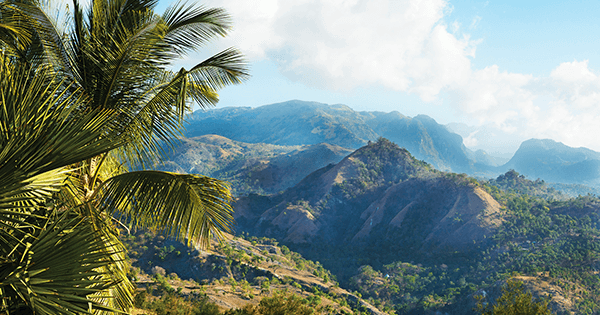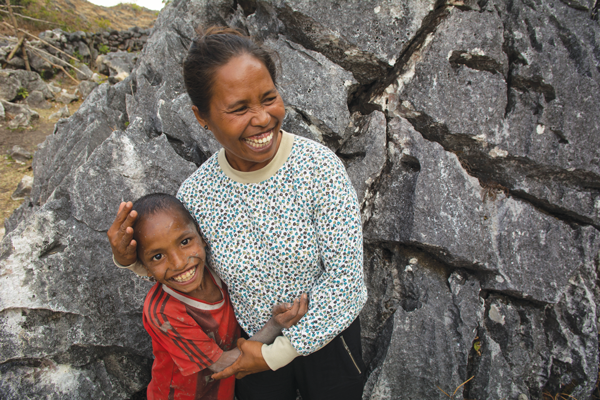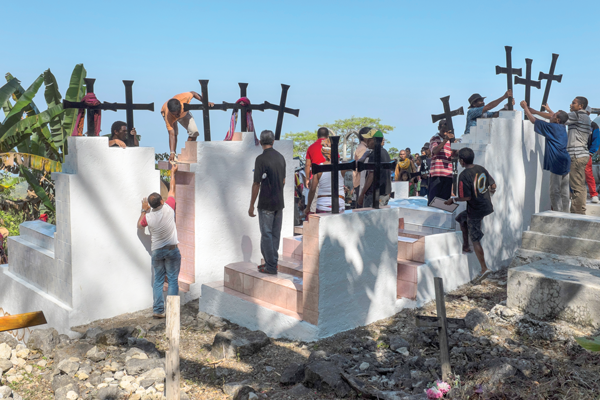East Timor: Mountain of Memory
Long ago, the country was home to lush rainforests, but during successive foreign occupations, loggers stripped away much of its tree canopy

Leopoldina Joana Guterres, better known to locals as “Mana Leo,” waits for us on the side of a pitted dirt street in Baguia, a hamlet in a mountainous region of East Timor. We’ve been traveling for seven hours in a rented Land Cruiser over horrendous narrow roads with blind curves and dizzying drop-offs when we see her, a Timorese woman standing alone in the darkness, wearing a black-and-white skirt and a wide smile. She leads us downhill to her house, a modest concrete structure that is home to more than 20 people—Leo’s kids, in-laws, nieces, and nephews, as well as a few students from remote villages who have come to Baguia to study. Leo herself is a principal who oversees half a dozen schools in the area, each of which she visits every few weeks, the farthest one a six-hour hike up Mount Rufaguia, the steep jut of rock and earth that flanks Baguia.
My husband, Jerry Redfern, and I have come here to speak with Leo about an innovative carbon offset program called WithOneSeed, which uses sales of Timorese coffee exported to Australia to finance reforestation in East Timor, paying farmers 50 cents a tree for each one they plant and nurture—up to $250 a year per farmer. Leo worked with her late husband, John, and an Australian community organizer named Andrew Mahar to found the program in 2010 in an effort to reverse a potentially catastrophic ecological loss. Long ago, the Southeast Asian country was home to lush rainforests, but during successive foreign occupations, first by Portugal, then Indonesia, loggers stripped away much of its tree canopy. Even today, as East Timor’s population grows, the forest continues to shrink. The consequences of this are far-reaching: increased risk of landslides, roads that become impassable during monsoons, poor soils that yield fewer crops. Climate change will only compound the problem. Last year, El Niño delayed the onset of the rainy season by months.
As we enter Leo’s house, it’s not trees she talks about first but her husband, the love of her life. Just inside her doorway is a makeshift shrine: a photograph of him sits on a table surrounded by artificial flowers and candles. A few years ago, Leo says, John started vomiting. He traveled to a clinic in Dili, East Timor’s capital, but died a short while later. After a period of mourning and depression, Leo says, she took over for him as manager of WithOneSeed—no easy feat in East Timor’s patriarchal culture. “The man says something, we say yes—like we need to obey,” Leo explains. But John was different, insisting that Leo give voice to her opinions. He is the reason, she says, that she shelters so many people in her home. “John always said to me, you help one or two people now, they will save 100 people in the future.”
Every few months, Leo climbs Mount Rufaguia to John’s grave. The route, she says, is full of cemeteries—as well as reminders of East Timor’s dark history. On Sunday, she will show us.
 Mana Leo and a boy named Paul (Jerry Redfern)
Mana Leo and a boy named Paul (Jerry Redfern)
East Timor, an independent nation north of Australia on an island shared with Indonesia, is one of the poorest countries in the world. Tuberculosis is rampant. Women die in childbirth; children die of diarrhea or a host of other preventable illnesses. Half of all Timorese kids are stunted by malnutrition. In recent decades, the misery was exacerbated by neglect, genocide, and war—all of which were more severely felt in remote places like Baguia, far from paved roads, hospitals, and services.
Portugal ruled the Timorese for 450 years until a 1974 coup in Lisbon led to a declaration of independence. Shortly thereafter, Indonesian soldiers invaded and stayed for 24 years, in one of the most brutal occupations of the 20th century. They shot, slaughtered, raped, tortured, and starved the Timorese, killing more than 200,000 people—a third of the population—in what today is widely recognized as a genocide. The Indonesian military bombed the interior mountains from the air, sea, and land. Leo was seven years old when the onslaught began. Her family, like many others, sought refuge in caves and subsisted on wild potatoes and beans. Leo carried her newborn sister at her hip so that her mother could forage for food.
For years, survivors have alleged that the Indonesians used napalm, and new evidence seems to support their claims. Clinton Fernandes, an associate professor at the Australian Defence Force Academy, has reportedly dug up previously classified Australian diplomatic documents indicating that Indonesian military officers had asked American experts to help them outfit U.S.-made Northrop F-5 fighter planes with napalm tanks.
The Indonesian occupation began with American consent. On the eve of the invasion, President Gerald Ford and Secretary of State Henry Kissinger met with Indonesian President Suharto, assuring him that the United States would understand if Indonesia took “rapid or drastic action” in East Timor, as Suharto put it. It’s no coincidence that East Timor sits along an oil-rich strait. “Roughly 90 percent of the military equipment used in the 1975 invasion was supplied by the United States,” writes UCLA historian Geoffrey Robinson. Successive American administrations continued to feed the Indonesian military machine, and Timorese civilians continued to die en masse.
But in 1999, Indonesia’s new president, B. J. Habibie, called on the Timorese to choose between “special autonomy”—which would have allowed local governments limited powers but kept Indonesia in control—and independence. Of the 98.6 percent of adults who voted, 78 percent chose independence.
In response, East Timorese paramilitary groups and Indonesian soldiers torched buildings, forcing hundreds of thousands of people to flee their homes. Street battles raged for weeks, prompting the deployment of international peacekeepers. The U.N. established a transitional administration that governed until May 20, 2002, when East Timor at last achieved independence.
 In the mountains above Baguia, Timorese men repair monuments in a cemetery where some of those killed by the Indonesian military are buried. (Jerry Redfern)
In the mountains above Baguia, Timorese men repair monuments in a cemetery where some of those killed by the Indonesian military are buried. (Jerry Redfern)
Jerry and I meet Leo at 7:50 Sunday morning, prepared to climb. The plan is to visit John’s grave and meet with farmers who have been planting trees for WithOneSeed. Already Leo has been up for nearly five hours. Most of Baguia’s women and girls rise before dawn to hike to the nearest freshwater spring, plastic water jugs in hand. During droughts like this, every drop of water used has been carried, by hand or head, into the hamlet.
On our way to John’s grave, Leo pauses in a clearing a few hundred feet up the mountain. This was the first stop for many families fleeing the bombs, she says. The people camped here for a night or two, then continued. Leo remembers hiking “two days, two nights, no food. Just move and move, so we were very weak.”
As fighting continued, refugees crowded the mountain, and food and water grew scarce. Leo says that even with the drought today, “now is good” compared with years of dry springs and dirty streams, and so many deaths from hunger and thirst. When people died on the mountain, their bodies were often left to rot. No one had the means or the strength to bury them. Sometimes, half a family died in one day. “In the morning, maybe the kids died, and in the afternoon, the father died.” Leo herself lost three uncles—one disappeared and was never seen again; two others died in violent attacks.
We huff a bit farther uphill. Then Leo points to a cluster of boulders, a shelter where people hid during the raids. The airplanes came every morning, she says. Villagers stayed hidden until noon, when the bombers took a break. “Then we could go outside to get something to eat,” she says. But the bombings resumed that afternoon. The planes flew so close, she says, that she could sometimes see the pilots. “We can see them, and they can see us.” She remembers holding her baby sister in a grip of fright, thinking they were about to die.
Baguia is obscured in the haze below as we continue to climb in breathtaking heat. We can see the coast now, a wavy line of hot brown earth against the sapphire sea. Up here, there are small villages, gardens, and watering holes. Cows and goats and bony horses. Leo picks frangipani blossoms from the edge of a terraced field to lay on John’s grave.
We meet a seven-year-old boy named Paul with mud-caked skin, big bright eyes, and bare feet. He grabs my hand and guides me through a field of rocks where monkeys like to play. Leo says Paul knew and loved her husband and often accompanies her to the cemetery.
John was a well-known man up here. With funding from NGOs, he built a new school with a giant water tank and classrooms large enough to accommodate more than 125 kids. But Paul has attended the school for only four months. His mother tells Leo that her son can’t get out of bed in the morning. He’s always late, so he stopped attending class. Leo keeps encouraging Paul to re-enroll, telling him it’s good for his future.
John’s grave is in the village of Rufaguia, near the base of another steep incline, where a vast wall of rock stretches another several hundred feet toward the sky. Here, we meet two of his cousins, Mariano Jose Gusmao and Domingos Barros da Cruz. Leo washes a spot on John’s concrete grave, already adorned with plastic flowers. She adds bananas and bougainvillea and hands each of us a candle to light. We stand by solemnly as she offers a teary-eyed message to her dead husband, giving him news of the family, the village, Baguia.
Afterward, we sit with Mariano and Domingos beneath a shady tree and talk. There is a mass grave farther up the mountain, say the cousins. One day in 1979, Indonesian soldiers (and a few Timorese who sided with them) gathered the men of the village and divided them into three groups. They shot every man in the first group, then every man in the second, Mariano says. Then they told the third group to go home. So long as the Timorese followed Indonesian orders, Leo says, they could live a semi-normal life under the eyes and guns of their occupiers. The Indonesians called this “integration.”
Lunchtime interrupts our grim discussion. Mariano’s house is nearby, and his wife, his mother, and five of his seven children are waiting for us, having prepared a feast. We sit beneath an open-air shelter propped up by wooden poles. In the center is a table with a white embroidered cloth and a meal of beans, rice, potatoes, greens, and canned tuna—a remarkable offering, purchased somewhere down the mountain, specifically for us. We eat and rest and chat with the family. Then Mariano wants to show us his trees.
Mariano is a participating farmer for WithOneSeed. Just down from his house and this makeshift dining hall are steep, terraced gardens and mahogany trees. He has 207 of them, each one lugged up the mountain as a sapling. “It is a long way to bring them up here,” he says, but he dreams of turning these hills into rich forests again, as they were centuries ago. Not every species thrives in his soil. Several mahogany trees have died for reasons unknown. But Mariano is undeterred. “I have plans to plant more trees,” he says, maybe eucalyptus or gum.
Mariano earns more than $100 per year from WithOneSeed. “I use that money to buy the things my family needs—like rice or food or clothes.” He also grows beans, corn, taro, and sweet potatoes and can sometimes sell enough to make a profit. But if a crop fails, he has no income. Trees are a crucial investment, Mariano says, for his finances—and his future.
In this way, Mariano and his family are tied to coffee farmers on the other side of the island in a region west of Dili known as Ermera, a day’s drive away. Mariano has never met those farmers, but their lives are no less entwined for that. Ermera farmers sell their organic Arabica coffee beans to buyers in Australia who participate in the companion program WithOneBean. There, the beans are roasted, packed, and sold. The proceeds of those sales sustain several environmental and educational programs in East Timor—including the carbon offset tree-planting initiative that pays growers like Mariano.
So far, WithOneSeed farmers have planted more than 50,000 trees that can do all the things Mariano mentions, and more—like “bring back all the birds,” Leo says. Every year, she takes her students into the forest, where they learn “the function of the trees” and how their systems work, through roots, trunks, branches, leaves, and bark, as well as their scientific and local names. The more kids know about trees, she says, the more they understand the importance of saving them.
We hike back down the mountain, Paul still skipping beside us. We pass a small watering hole where women gather with plastic containers. The weeds are so brittle, they crunch beneath our feet. If it doesn’t rain soon, Leo says, disease will spread. But if the rains do come, that will mean trouble, too. Mosquitoes will bring fever. Erosion will block the road. There are no worry-free times in Baguia—and perhaps that’s why Leo clings so hard to life.
Every night at dinner, she sets out a bowl of food and a cup of water for John. Then she prays for good health, her family, her environment, and the future of Baguia.
Karen Coates traveled to East Timor on an International Reporting Project fellowship to cover health and development.

